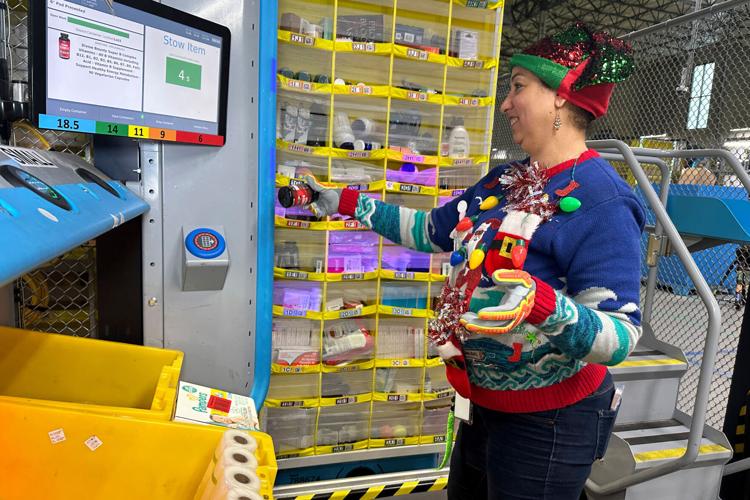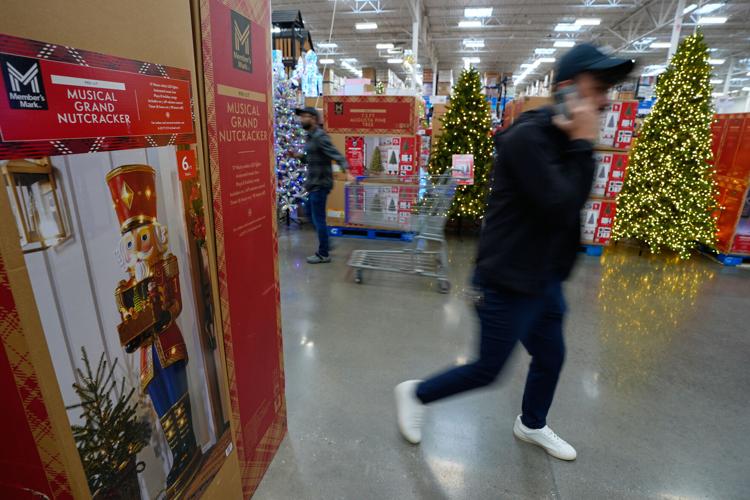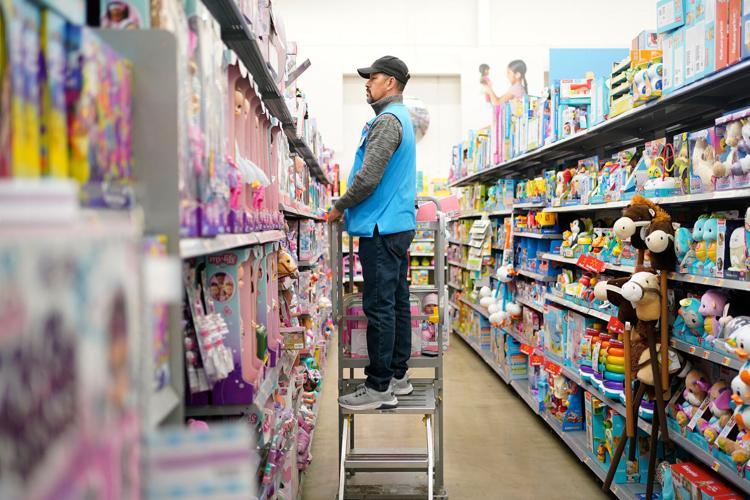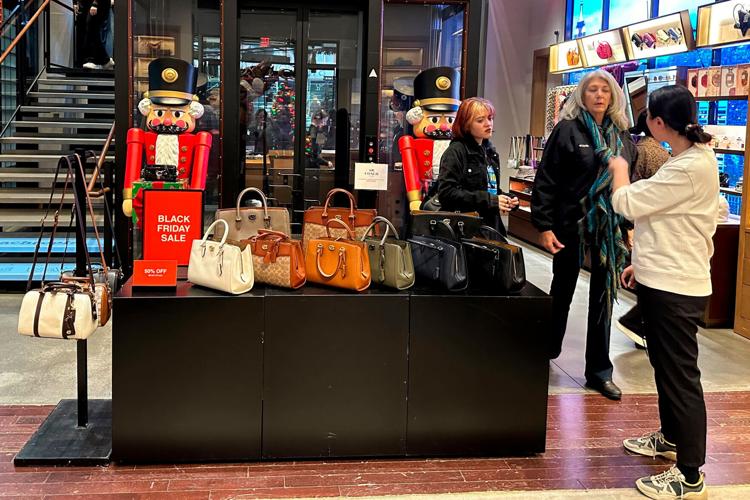NEW YORK ŌĆö Uncertainty over the and is forcing retailers to pull back or delay plans to hire seasonal workers who pack orders at distribution centers, serve shoppers at stores and build holiday displays during the most important selling season of the year.
American Christmas LLC, which creates elaborate holiday installations for commercial properties such as New York's Rockefeller Center and Radio City Music Hall, plans to hire 220 temporary workers and is ramping up recruitment nearly two months later than usual, CEO Dan Casterella said. Last year, it took on 300 people during its busy period.
The main reason? The company wants to offset its tariff bill, which Casterella expects to be as big as $1.5 million this year, more than double last year's $600,000.
People are also reading…
"The issue is if you overstaff and then you underperform, it's too late," Casterella said. "I think everyone's more mindful now than ever. "

An Amazon employee works in a same-day delivery fulfillment shipping center Dec. 18, 2023, in Woodland Park, N.J.
Hiring could fall to 2009 levels
Online behemoth Amazon Inc. said Monday it intends to hire 250,000 full-, part-time and seasonal workers for the crucial shopping period, the same level as a year ago.
But job placement firm Challenger, Gray & Christmas forecasts overall holiday hiring for the last three months of the year will likely fall under 500,000 positions. That's fewer than last year's 543,000 level and also marks the smallest seasonal gain in 16 years when retailers hired 495,800 temporary workers, the firm said.
Among other companies cutting holiday payrolls: Radial, an e-commerce company that powers deliveries for roughly 120 companies like Lands' End and Cole Haan and operates 20 fulfillment sites. It plans to hire 6,500 workers, fewer than last year's 7,000, and is waiting to the last minute to ramp up hiring for some of its clients, chief human resources officer Sabrina Wnorowski, said.
Bath & Body Works, based in Reynoldsburg, Ohio, said it plans to hire 32,000 workers, below the 32,700 a year ago.

People shop among holiday displays at a Sam's Club on Sept. 24 in Bentonville, Ark.
"We saw real strong signals that there's been a cooling in the labor market, even beyond what our expectations were in the first nine months of the year," Challenger's senior vice president Andy Challenger said.
Challenger also noted companies are using artificial intelligence bots to replace some workers, particularly those working in call centers. And he's also seeing companies hiring workers closer to when they need them.
Meanwhile, the list of companies staying mum about their specific holiday hiring goals keeps growing. Target Corp., UPS and Macy's are declining to offer figures, a departure from years past.
Holiday hiring a┬Āclue to spending
Retailers' hiring plans mark the first clues to what's in store for the U.S. holiday shopping season and come as the U.S. job market has lost momentum this year, partly because Trump's trade wars have created uncertainty that's paralyzing managers trying to make hiring decisions.
The Labor Department reported in early September that U.S. employers ŌĆö companies, government agencies and nonprofits ŌĆö added just 22,000 jobs in August, down from 79,000 in July and well below the 80,000 that economists had expected.
The government shutdown, which started Oct. 1 and has delayed the release of economic reports, could worsen the job picture.
In an attempt to exert more pressure on Democratic lawmakers as the government shutdown continues, the White House budget office said Friday mass firings of federal workers have started.
Analysts will be closely monitoring the shutdown's impact on spending. For now, many retailers say that consumers, while resilient, are selective. Analysts will also be watching how shoppers┬Āwill react to price increases as a result of high tariff costs in the next few months, experts said.

Shoppers pause near a display of handbags Nov. 19, 2023, at a Coach store in New York.
Given an economic┬Āslowdown, holiday spending growth is expected to be smaller than a year ago, according to several forecasts.
Mastercard SpendingPulse, which tracks spending across all payment methods including cash, predicts that holiday sales will be up 3.6% from Nov. 1 through Dec. 24. That compares with a 4.1% increase last year.
Deloitte Services LP forecasts holiday retail sales to be up between 2.9% to 3.4% from Nov. 1 through Jan. 31. That's compares with 4.2% last year.
And Adobe expects U.S. online sales to hit $253.4 billion from Nov. 1 to Dec. 31, representing a 5.3% growth. That's smaller than last year's 8.7% growth.
A more flexible approach
Companies are increasingly wanting to hire workers closer to when they need them, experts said.
"In today's environment, brands are really looking for us to be agile," Radial's Wnorowski said.
So for some of its clients, Radial will now be hiring two weeks before Thanksgiving weekend, the traditional start for the season, instead of four weeks before the kickoff. Radial is also training holiday hires faster with new technology that's simplifying their tasks. It used to take a couple of days to train a worker, but now it only takes a couple of hours, she said.
Meanwhile, Target will offer current workers additional hours and then will tap into a separate pool of workers ŌĆö 43,000 ŌĆö who pick up shifts. The Minneapolis-based company also hires seasonal workers across its nearly 2,000 stores and more than 60 distribution facilities to meet demand, it said.

An employee stocks shelves Nov. 22, 2022, in the toy section of a Walmart in Secaucus, N.J.
For the past few years, Walmart, the largest private employer, has been offering its workers extra hours available during the holidays, a Walmart spokesperson said, noting it's worked well and the feedback from customers and workers has been "overwhelmingly positive."
The Bentonville, Arkansas-based retailer said there may be some seasonal hiring on a store-by-store basis, but most locations will dole out those hours to current workers.
Waiting until the last minute to hire could mean a mad┬Āscramble to find talent, but companies say that with the slowing economy, they don't anticipate having a hard time.
The top retail trends in 2025
The top retail trends in 2025

The retail industry is entering a transformative era. Consumer habits are shifting rapidly, economic pressures remain high, and technology is becoming a competitive differentiator. To stay ahead, retailers must rethink revenue models, like never before, and embrace new strategies that balance┬Ā with digital convenience.┬Ā
To help retailers identify and lean into strategies that satisfy consumers' evolving preferences, teamed up with Bredin and surveyed 2,000 retail owners and 4,000 consumers in the U.S., Canada, the U.K., and Australia. It found that while consumers are looking for convenience and flexibility, they also value in-person experiences more than expected. Retailers are responding by investing in , expanding revenue streams beyond traditional product sales, and leveraging automation to enhance customer service and operations. At the same time, personalization has become a critical factor in consumer engagement, with data-driven marketing and playing an increasingly important role in retention.
Square analyzed the survey results, insights from its retail team, and interviews with creative retailers leading the charge to identify the top retail trends for businesses to explore this year. All data cited below comes from the survey results. For a more in-depth look at these retail industry trends, read the .
Retailers Are Using More Technology Than You Think, and it's Paying Off
Technology has always played an important role in retail, from RFID tags to . But in 2025, retailers are going beyond the usual tools and experimenting with automation and . According to our research, 93% of retailers have implemented automation in at least one part of their business. From AI-powered product recommendations to automated inventory tracking and self-checkout systems, retailers are using technology to manage daily tasks that once required significant manual effort. 70% of retail leaders say they now rely on data analytics to guide purchasing decisions.
Brands like in Chicago use inventory management tools to manage more than 10,000 SKUs with a lean staff. "I wanted to be able to bring the same scale of brands and product offerings in different categories as the store in Charlotte, but we would have to have multiple full-time people managing this many SKUs if we were doing it manually," said founder Elisabeth Emory.
For retailers looking to maximize the benefits of automation and artificial intelligence, the key is to start small and be strategic. Invest in tools that address the most time-consuming tasks first, such as or marketing automation, and gradually expand from there. Most importantly, regularly gather customer feedback to ensure that new technologies are improvingŌĆönot complicatingŌĆöthe shopping experience.
Retail Leaders Believe in New Revenue Streams, but Many Aren't Acting
In an industry that thrives on reinvention, 70% of retailers recognize that supplemental revenue streams, like memberships, subscriptions, and experiential retail, are critical for future success. Yet only a fraction are actually implementing them. Less than one-third of retailers said they experimented by holding events, adding memberships or a club offering, or adding new products and services in the last year.
Retailers who have tried are already seeing results. Take , for example. The specialty alcohol retailer has built its brand by featuring local makers and hosting community events.┬Ā
Retailers that experiment with new revenue models stand to gain long-term customer loyalty and financial resilience. For those unsure about where to begin, the best approach is usually to test ideas gradually. Retailers can start by identifying their most engaged customers and offering exclusive perks, such as early access to new products, VIP shopping events, or subscription-based discounts. Hosting limited-time in-store experiences or with local businesses can also be an easy way to gauge customer interest.┬Ā
If experimenting feels daunting, tools like Square make it easy to integrate new offeringsŌĆöwhether it's subscriptions, memberships, or event ticketingŌĆöwithout disrupting core operations. By taking an incremental approach, retailers can explore new revenue streams with minimal risk while keeping their primary business running smoothly.

Retailers Must Get Creative to Win Over Hesitant Shoppers

Consumers are pulling back on spending, but that doesn't mean they're unwilling to shopŌĆöit just means retailers need to work harder to earn their business. 58% of consumers say they've cut spending in the last 12 months, yet 64% of retailers plan to raise prices. This creates a challenge that retailers must solve strategically. Retailers that rethink pricing strategies and offer creative payment solutions will be in a stronger position to navigate consumer uncertainty in 2025.
One approach gaining traction among retailers and consumers is . Retailers who offer BNPL have seen a 73% increase in usage over the past year, suggesting that consumers are becoming more comfortable with installment payment plans as a way to manage their budgets.
Another strategy retailers are testing is strategic loss leadersŌĆöoffering heavily discounted items to draw customers into the store with the expectation that they will purchase additional products. Grocery stores have long used this method by discounting essentials like milk or eggs, knowing that shoppers are unlikely to leave with just one item. For example, is strategically priced to draw customers into the store, where they often end up buying other items, thereby increasing overall sales. Clothing retailers, too, often promote steep markdowns on select styles to increase foot traffic while relying on full-price purchases to balance the margins.
For retailers looking to implement these strategies effectively, the first step is to leverage business data to uncover customer spending trends. Look at transaction history to determine which products are frequently purchased together, which items have the highest margins, and which price points customers respond to most.┬Ā
For example, if data shows that customers who buy coffee machines often return for premium coffee beans, bundling those products with a small discount could encourage larger purchases. By taking a data-driven, long-term approach, retailers can navigate shifting consumer spending habits while maintaining sustainable growth.
Balancing Brick-and-Mortar Quality and Online Convenience is Key
Retailers who offer a seamless will be the biggest winners in 2025. While online shopping continues to grow, brick-and-mortar remains a crucial part of the consumer experience. In fact, 78% of retailers say in-store experiences are key to their future success, and 83% of consumers report positive experiences with brick-and-mortar shopping.┬Ā
Take in Illinois, for example. The family-run business has seen 15% growth without increasing its team size by leveraging in-person experiences like farmers markets. The team hosts local vendors and families in a community-driven bazaar and offers thousands of gardening and plant supplies online and in person.
Businesses like Barn Owl Garden Center are on the right track since consumers increasingly expect more flexibility in how they shop. 58% of consumers say they prefer retailers that allow them to buy online and return in-store, and 65% want the option to check in-store availability online before visiting. Smart retailers must invest in technologies that make these transitions seamless. For example, a cloud-based POS system that integrates both online and in-store sales can help businesses manage inventory in real time, preventing stock discrepancies and ensuring customers get accurate product availability.
Personalization and Alerts Are Essential
For years, retailers feared that too many notifications would annoy customers. That's still largely true, but the data provides important context: Almost two-thirds of consumers (64%) want to receive personalized alerts and notifications based on their past purchases. So, while generic messages will often go unnoticed or even annoy customers, relevant personalized messages keep them engaged and your business top of mind.
And when it comes to personalization, loyalty programs play a crucial role. More than 80% of consumers actively seek exclusive discounts and rewards with loyalty programs, and 82% of retailers with loyalty programs say they drive repeat business. Shoppers expect more than just a basic rewards program, however. They want offers tailored to their shopping habits, whether it's a birthday discount, early access to sales, or surprise perks based on their favorite products.┬Ā
Ryan Nesci, co-owner of in Canada, has seen firsthand how personalization fuels retention. "These tools let me automate offers, customize email campaigns, and create special birthday offers for our loyal customers." This approach has helped the business grow steadily, expanding to two locations with 15 employees since 2018.
Retailers can use tools┬Āthat segment customers based on purchase history and engagement levels to ensure messages feel relevant and timely rather than mass-distributed.
Rethinking Hiring for the Long Term Is a Must
Retailers say hiring has become easier, with 52% reporting that it's less challenging than the previous year. However, simply filling open positions isn't enoughŌĆöretailers need to build a stable and motivated workforce.┬Ā
Despite recognizing the need for retention, fewer than 38% of retailers offer structured career paths for employees. This lack of professional development opportunities contributes to the perception that retail jobs are temporary rather than viable long-term careers. Although retailers say they run an average of four initiatives to retain staff and grow their skills, no single initiative has been widely adopted. For example, only 38% of retailers offer flexible schedules, and only 33% pay wages at or above market rates. Without a clear strategy, many businesses risk losing valuable employees to competitors offering better growth prospects.
Retailers interested in long-term growth must rethink their approach. Investing in and empowerment isn't just good for morale, it directly impacts the bottom line. Employees who see a future in retail are more engaged, more productive, and more likely to stay, reducing costly turnover and strengthening customer relationships. Providing ongoing education through mentorship programs, cross-training, or leadership workshops helps employees build skills and envision long-term career growth within the company. Clear advancement opportunitiesŌĆöwhether through promotions, skill-based incentives, or management training programsŌĆödemonstrate that employees have a future beyond their current roles.┬Ā
Another important way to is to give employees the tools they need to work more efficiently. Streamlining operations with the right technology can reduce administrative burdens and free up employees to engage in more meaningful interactions with customers.
Build a Thriving Retail Business
The future of retail belongs to businesses that embrace change, prioritize customer experience, and leverage technology to stay ahead. Consumers are looking for convenience, flexibility, and meaningful engagementŌĆöand retailers that deliver will build lasting loyalty and sustainable success.
was produced by┬Ā for its publication┬Ā and reviewed and distributed by Stacker.












